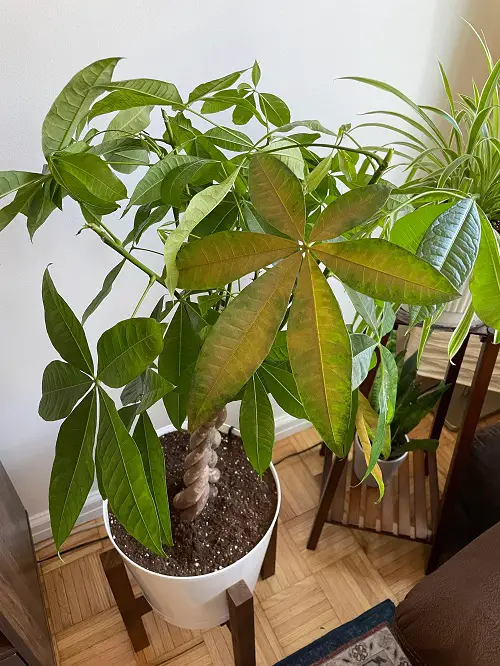Worried about Money Tree Leaves Turning Yellow? Learn about the common causes and how to fix them with easy tips and tricks.
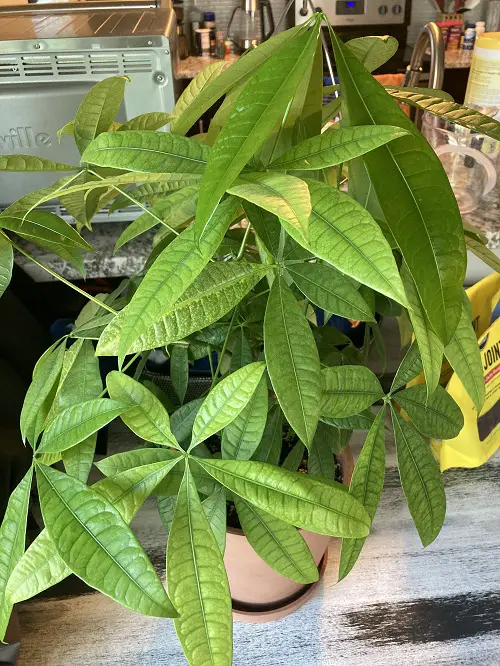
Confused about why your Money Tree Leaves Turning Yellow again and again? Do not worry. We are going to give you all the reasons behind it along with their solutions!
Learn Growing Money Tree as Houseplant here
Money Tree Leaves Turning Yellow – Reasons and Solutions
# 1 Reason: Inconsistent Temperature
Yellow leaves on your money tree could be caused by temperature fluctuations if the plant is located near a heating vent, air conditioning unit, drafty window, or doorway.
The ideal temperature range for Pachira aquatica is between 65°F to 75°F (18°C to 24°C). However, the plant can tolerate temperatures as low as 50°F (10°C) and as high as 90°F (32°C) for short periods of time.
Solution: To prevent this, move the plant to a location where it is safe from sudden changes in temperature. An ideal spot would be near an east facing window.
# 2 Reason: Too Much Light
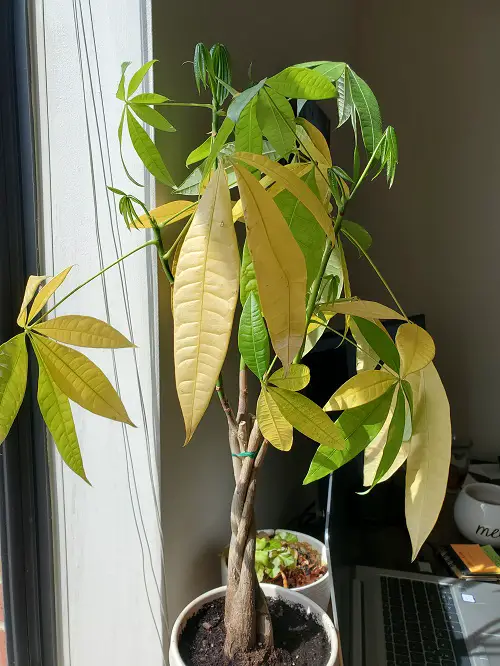
Money tree thrives in bright but indirect light. Another reason behind money tree leaves turning yellow is excessive light or direct sunlight, particularly that comes from a south-facing or west-facing window – it can result in pale yellow patches on the otherwise healthy green leaves.
Solution: To fix this, move the plant away from the light source to a spot with indirect sunlight or install a sheer curtain to filter the light. The best is to keep it at a spot where it gets direct sun for 3-4 hours in the morning and dappled light for the rest of the day.
# 3 Reason: Pest Infestations

Common pests that can affect Pachira aquatica include spider mites, mealybugs, scale insects, and fungus gnats. These pests can cause significant damage to the plant by feeding on its sap, weakening the plant, and making it more susceptible to other pests and diseases.
Solution: To control pest infestations, it is important to regularly inspect the plant for signs of pests and take prompt action to control them. This can involve spraying the plant with a solution of water and neem oil or insecticidal soap, wiping the leaves and stems clean with a damp cloth, or using sticky traps to capture flying pests.
Click here to learn about the Amazing Natural Pesticide Recipe that can Kill any Pest
# 4 Reason: Not Enough Humidity
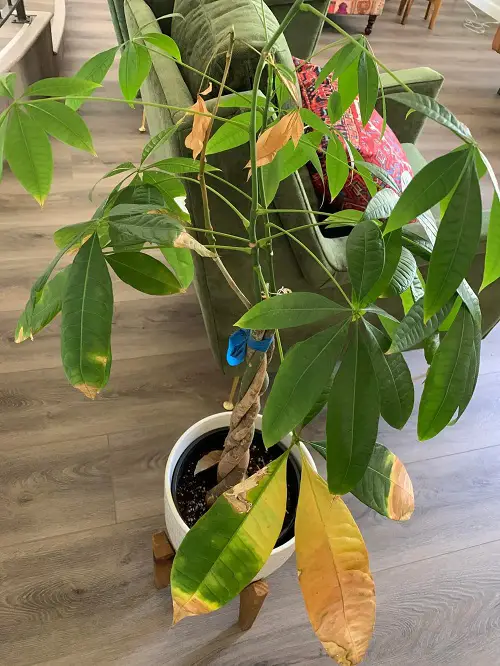
Money trees are originally from the Central and South American tropics, where they prefer swampy environments. To thrive indoors, they need a space with at least 50 percent humidity. If they do not get this range, then it can be a cause of money tree leaves turning yellow.
Indoor conditions in colder climates tend to be much drier, especially in the winter. This dryness, coupled with blowing air from ventilation systems, can cause your money tree’s leaves to develop crispy brown edges before wilting and falling off.
Solution:
- Use a Humidifier: A humidifier is an easy and effective way to increase the humidity levels in a room. Place a humidifier near your Pachira aquatica to add moisture to the air.
- Group Plants Together: Grouping plants together can help create a microclimate that is more humid than the surrounding air. This is because plants release moisture through a process called transpiration, which can help increase the humidity levels in the area.
- Mist the Leaves: Use a spray bottle filled with water to mist the leaves of your Pachira aquatica. This can help increase the humidity levels around the plant.
- Use a Pebble Tray: Place a layer of pebbles in a tray and add water. Place your Pachira aquatica on top of the pebbles, making sure that the bottom of the pot is not submerged in the water. As the water evaporates, it will help increase the humidity levels around the plant.
Here are 10 Ways To Increase Humidity For Houseplants That Work
# 5 Reason: Overwatering
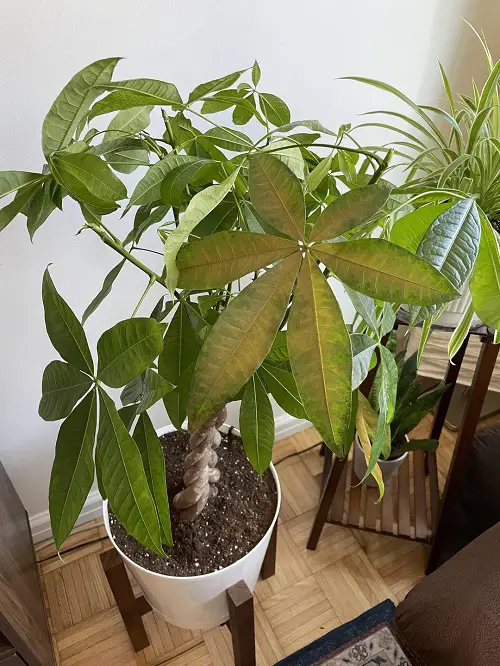
Overwatering is a frequent culprit behind money tree leaves turning yellow. If you water your plant too frequently, use a pot without drainage holes, plant it in heavy soil, or leave it sitting in water, it can lead to root rot.
This condition hinders the plant’s ability to absorb water and nutrients from the soil, and if left unchecked, it can result in the plant’s demise.
Solution:
- Check the Soil Moisture: Before watering your Pachira aquatica, check the soil moisture level. Stick your finger about an inch into the soil. If it feels dry, then it’s time to water the plant. If it still feels moist, then wait a few days before watering.
- Water Thoroughly but Less Frequently: When you do water your Pachira aquatica, water it thoroughly, making sure that the water drains out of the bottom of the pot. However, don’t water the plant too frequently. Allow the soil to dry out slightly between watering.
- Use Well-Draining Soil: Pachira aquatica prefers well-draining soil that allows excess water to drain away from the roots. Make sure the pot has drainage holes at the bottom to allow water to escape.
- Choose an Appropriate Pot Size: Make sure that the pot you choose for your Pachira aquatica is the appropriate size. A pot that is too large can lead to water accumulating in the bottom of the pot and causing root rot.
- Use a Moisture Meter: Consider using a moisture meter to help you determine when it’s time to water your plant. This can be a useful tool to help prevent overwatering.
Take a look at Signs of Overwatering & How to Save an Overwatered Plant here
# 6 Reason: Low Light
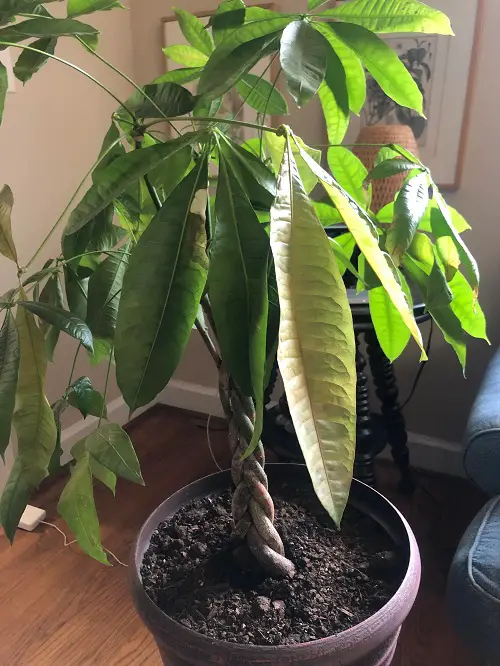
If the plant does not receive enough sunlight, the leaves can turn yellow and drop off. This is because sunlight is essential for photosynthesis, the process by which plants produce energy and food.
Solution:
To prevent yellowing leaves caused by low sunlight, make sure to place your Pachira aquatica in a location where it will receive bright, indirect light. This can be near a window that receives sunlight but is not exposed to direct sunlight. You can also use a grow light to supplement the light if natural light is not sufficient.
# 7 Reason: Nutrient Deficiency
- Nitrogen Deficiency: Nitrogen is essential for plant growth and is a key component of chlorophyll, the pigment that gives plants their green color. When Pachira aquatica does not receive enough nitrogen, the leaves may turn yellow, and the plant may stop growing.
- Iron Deficiency: Iron is essential for the production of chlorophyll and helps to regulate the plant’s metabolic processes. When Pachira aquatica does not receive enough iron, the leaves may turn yellow with green veins.
- Magnesium Deficiency: Magnesium is essential for the production of chlorophyll and is involved in the plant’s metabolic processes. When the plant does not receive enough magnesium, the leaves may turn yellow, and the plant may become stunted.
- Potassium Deficiency: Potassium is essential for the plant’s overall health and helps to regulate its water balance. Without enough potassium, the leaves may turn yellow, and the plant may become weak and susceptible to pests and diseases.
Solution:
Look for a fertilizer that contains equal amounts of nitrogen, phosphorus, and potassium (such as a 10-10-10 or 20-20-20 formulation). For best results, fertilize once a month during the growing season (spring and summer) and reduce or stop fertilizing during the dormant season (fall and winter).
Check out these Money Saving Gardening Tips
#8 Reason: Underwatering

Underwatering is another common cause of money tree leaves turning yellow. When the plant does not receive enough water, it can become stressed and may show signs of dehydration, such as yellowing leaves.
Solution:
To prevent yellowing leaves caused by under-watering, make sure to water your Pachira aquatica regularly and consistently. Check the soil moisture level frequently, and water the plant when the soil feels dry to the touch. It is also important to use well-draining soil and a pot with drainage holes to prevent the plant from becoming waterlogged.
Here are Sure Shot Signs of Underwatered Plants
#9 Reason: Poor Drainage

When the growing medium does not drain well, it can become waterlogged and cause the roots to become damaged and deprived of oxygen. This can lead to root rot, which can cause the leaves to turn yellow and fall off.
Solution:
To prevent yellowing leaves caused by poor draining soil, make sure to use well-draining soil when planting your Pachira aquatica. Use a pot with enough drainage holes to allow excess water to escape from the soil and avoid overwatering the plant. If you notice that the soil is not draining well, consider repotting the plant in fresh, well-draining soil.
#10 Reason: Due to Age and Growth Cycle

Age and growth cycle can also be a factor in money tree leaves turning yellow. As the plant ages, it may naturally shed its older leaves, which can turn yellow before falling off. This is a normal part of the plant’s growth cycle and is nothing to be concerned about.
In addition, if the plant is not growing or producing new leaves, it may indicate that it has reached the end of its growth cycle. As the plant matures, it may become less productive and start to show signs of decline, such as yellowing leaves.
Check out 11 Best Herbs that Attract Money here
How to Control Yellowing of Foliage?
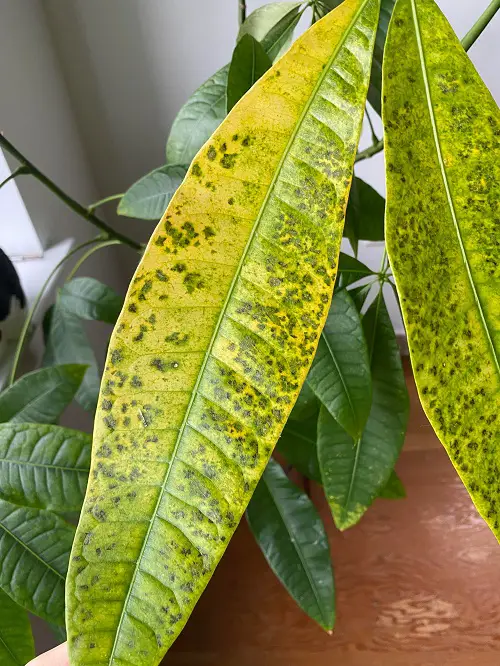
Consistent care and proper growing conditions are key to preventing yellow leaves on your money tree. Keeping an eye out for pests and addressing any issues promptly can also help. If you do notice yellowing, take action to prevent further damage.
Keep in mind that occasional yellow leaves are normal and not a cause of concern on a generally healthy money tree.



